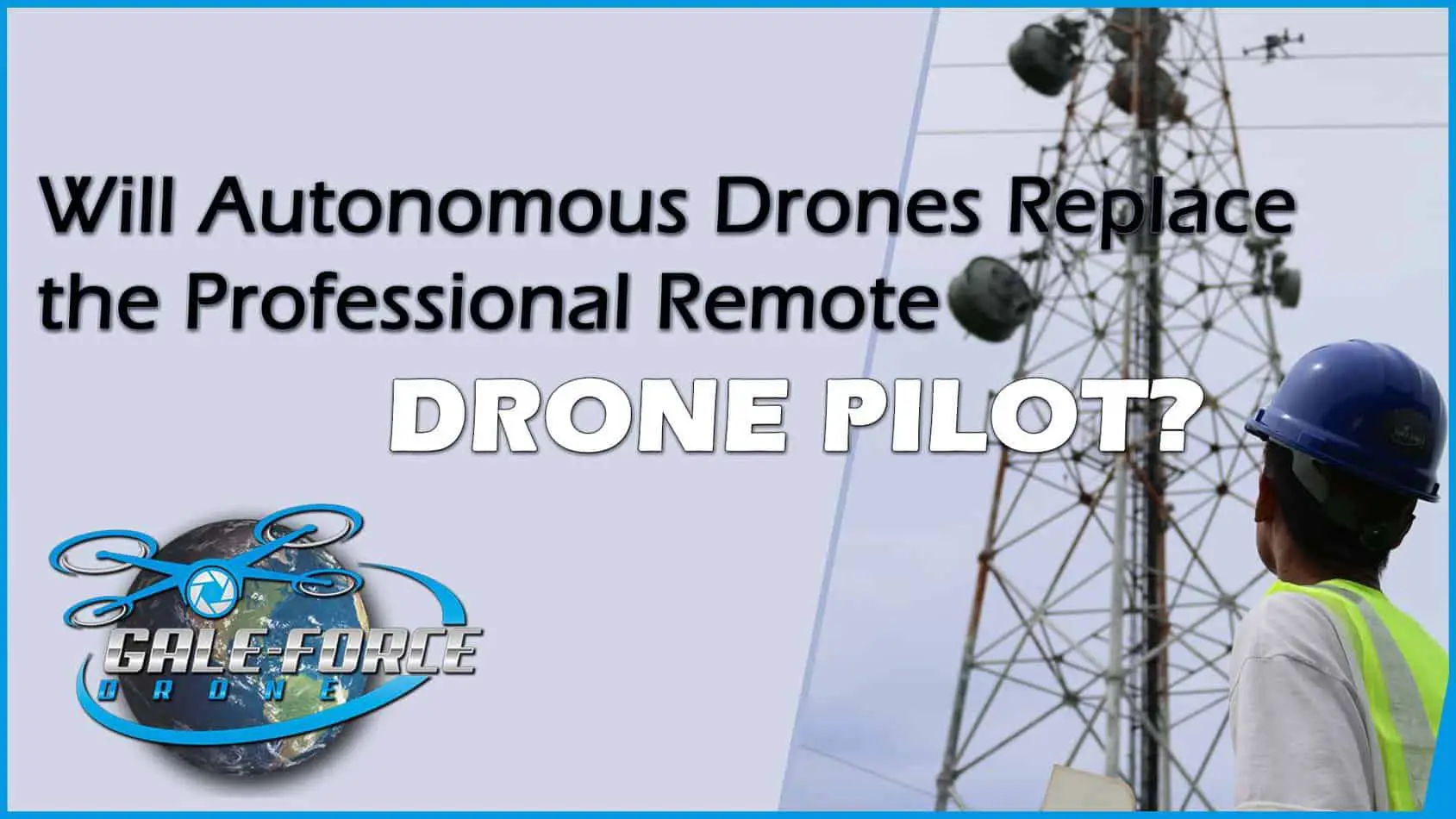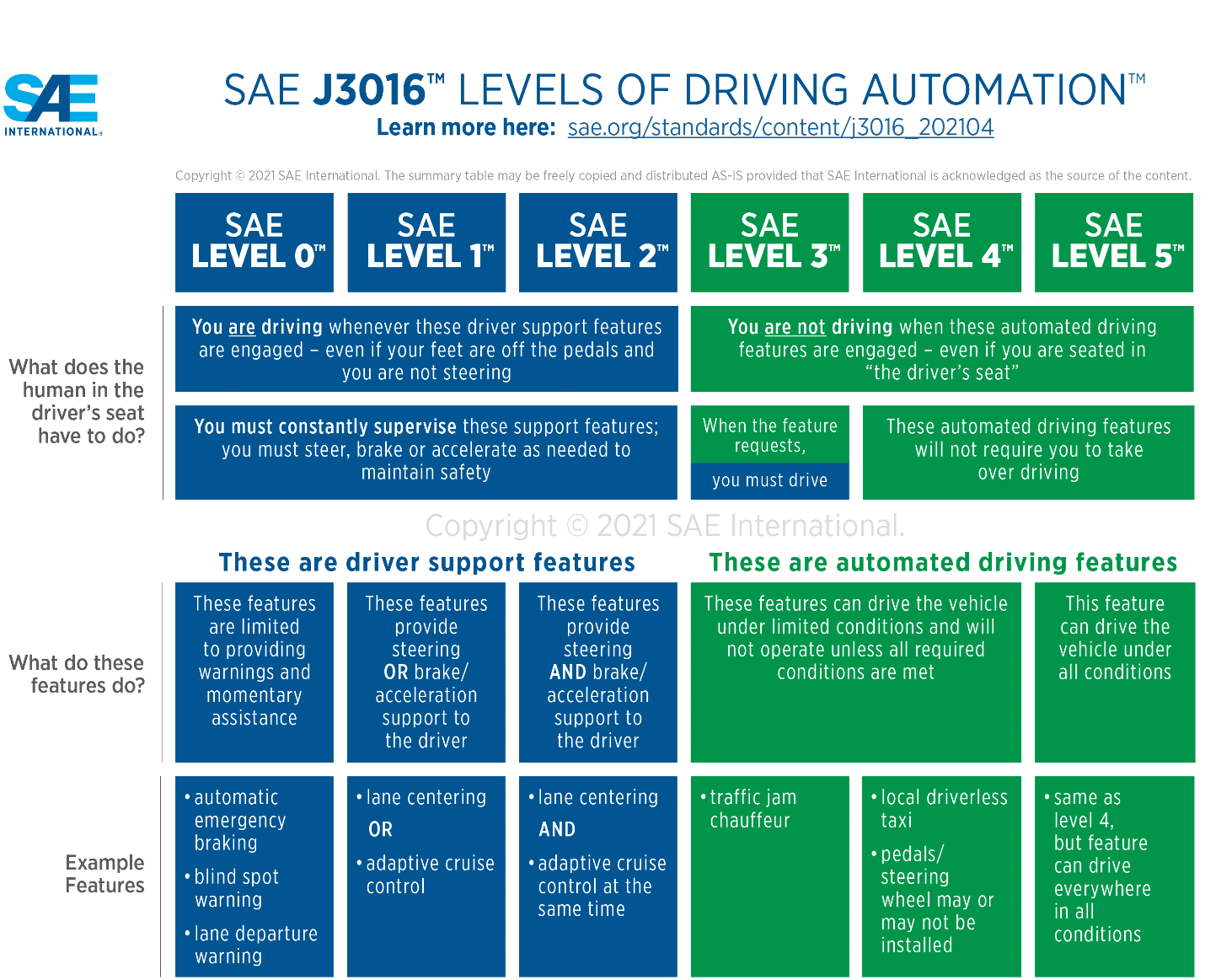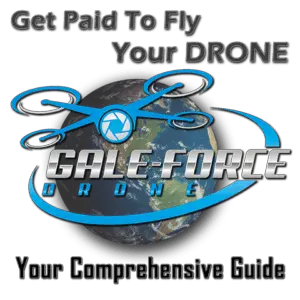
Autonomous drone solutions are already available in the market, but are still a ways from replacing the human drone pilot. I reached out to a well-known Drone Service Provider based in Germany, asking his opinion if autonomous drones will replace the drone pilot, and this was his answer;
“…it’s the future… for most applications, there won’t be a need for pilots anymore.”
In this article, we are going to address this very important trend in the industry; autonomous drones and drone autonomy and how we can leverage this technology to do your work for you, as well as how they can do your thinking for you.
Introduction…
My primary mission here with Gale-Force Drone, is to provide real world guidance helping new Drone Pilots to begin making money with your drone. We spend a lot of time discussing different drone platforms, sensors and their varying use cases and how to leverage minimal gear to make money for your drone startup business.
Is The Future Now?
As more global capital is invested into the drone industry, technological advancements will continue to reduce the human workload. Even today, it is now possible to plan a flight mission, conduct the flight, and deliver a useful data set and report to your customer with just a few strokes on the keyboard, never leaving your home.
Drone technology is evolving faster than lawmakers can keep up. The FAA is known to be a late adopter of technology trends, and the U.S. lags almost every other country in employing drones to their fullest potential. Restrictions on flight over populated areas, BVLOS(1) requirements, maintain the ability to take manual control, and prohibited multi-drone operations are some of the key barriers to unleashing fully autonomous commercial drones.
These policies should begin to relax over time as new technical breakthroughs emerge. Will Autonomous Drones Replace the Drone Pilot? Will we drone pilots ourselves become obsolete?
While I don’t believe so, I never say never and time will certainly answer this question. Our autonomous airplanes still have human pilots, and our self-driving cars still have human drivers. I believe that the same will be said of drone pilots; we are still part of the equation, but technology is making it so that we can be a bit less hands-on.
Now, I do fully believe that our role as drone pilots will continually evolve. Instead of being so much the hands-on pilot, I see our role becoming Mission Monitors and Process Managers. We will take a step back from the demands of flying the drone, and instead more focus on optimizing the way we deliver value to our customers. Traditional pilots learn “Aviate, Navigate, Communicate”; I believe drone pilots should be focusing on “Automate, Integrate, Disseminate”.
Of all professions, ours continues to innovate at astounding speeds. We are at the verge of some exciting times for the drone industry, so let’s make sure we are ready for the change.
Now, let’s go outside and practice some ATTI mode!
(1) beyond visual line of sight
What Does Autonomous Mean?
There are a lot of interesting words that start with the “auto” prefix. Let’s look at a few.
Automatic: Working by itself with little or no direct human control.
Automated: Operated largely by automatic equipment.
Autonomous: (1) Having the freedom to act independently; (2) Performed by a device capable of operating without direct human control.
The three terms have been used somewhat interchangeably, and our understanding of autonomy continues to evolve over time. Autonomy is a spectrum. At the core of the concept is the idea of human control. Namely, how much control the human must have, or is allowed to have.
What does it mean for a device to be autonomous? This is an intriguing question, so let’s spend some time thinking about it.
If a device has only one job, then this seems straight forward, right? For example, a thermostat’s sole function is to maintain a constant temperature. Thermostats regulate the temperature in ovens, homes, and computer processors. They activate heating or cooling devices when a temperature threshold is triggered, and deactivate when a different threshold is achieved, all without human intervention. So thermostats are fully autonomous, right?
Not exactly. A human still defines the target temperature. The cook sets the baking temperature, the homeowner sets the HVAC temperature, and the processor manufacturer sets the optimal operating temperature. If the thermostat was fully autonomous, it would choose the temperature for us.
Let’s take a look at autonomous vehicles.
Self-driving cars have been headline news, particularly when the technology is paired with Electric Vehicles (EVs). The concept is gaining enough traction that the Society of Automotive Engineers (SAE International) has defined a standard taxonomy to describe the vehicle’s behavior (SAE J3016).
Level 0: No Driving Automation
Level 1: Driver Assistance
Level 2: Partial Driving Automation
Level 3: Conditional Driving Automation
Level 4: High Driving Automation
Level 5: Full Driving Automation

I appreciate how SAE International determined that autonomy is not a binary attribute (as in, “it’s either autonomous, or it’s not”). Instead, they define the level of automation by the machine’s behavior with certain tasks. At the low end of the automation scale, the human has the option to control some functions; at the high end of the automation scale, the human does not have the option to control some functions.
Fun fact: the first U.S. coast-to-coast autonomous vehicle journey was conducted in 1995; the computer steered, but the human operated the throttle and brakes.
Even a Level 5 self-driving vehicle is not fully autonomous; the human still sets the destination, start time, music, and cabin temperature. I would argue that a future Level 6 vehicle would tell me when to get into the car, and it would pick the destination, music, and temperature for me.
This hypothetical Level 6 seems ridiculous, but it’s actually close to how a monorail works. Monorails are common methods of transportation at large airports and theme parks, safely and efficiently moving people between fixed points. The last time I looked, there was no human operator at the front, so it fits the definition of an unmanned vehicle. As a passenger, the only control I have is an Emergency Stop button. The machine makes the following decisions without giving me any control:
- Origin
- Destination
- Start Time
- Stop Time
- Route of Travel
- Speed
- Obstacle Detection
- Health and Status
- Monitoring
- Cabin Temperature Regulation
Wow, we’ve been riding in Level 6 autonomous vehicles for years!
We tend to imagine autonomous vehicles as having a high level of artificial intelligence, but we can clearly see that low levels of task automation accumulate to fully autonomous vehicles.
Ground vehicles are boring, right? Let’s talk about aircraft!
- The U.S. Air Force conducted the first transoceanic flight on autopilot, including takeoff and landing, in 1947.
- NASA developed the first digital autopilot for the Lunar Module during the Apollo program in the 1960s. Neil Armstrong took manual control during his descent to the moon, as did his successors.
- Commercial airlines began integrating automated tools in the cockpit during the 1970s, reducing the human crew from 5 members down to 2 (pilot and copilot).
Modern passenger aircraft are almost completely automated, and pilots take manual control only by exception. Even this manual control is still “fly by wire”, in which a flight computer translates the pilot’s control inputs into control surface outputs.
How do pilots interact with an autopilot-controlled airplane?
- Input the route of flight (which was generated by autonomous flight-planning software)
- Input the altitude (which was generated by autonomous flight-planning software)
- Input the speed (which was generated by autonomous flight-planning software)
- Hit the Autotakeoff and Autoland buttons if the airplane is equipped
- Input any changes to flight route or altitude as assigned by ATC
- Monitor the aircraft health and status
- Manually fly the aircraft during certain emergencies or weather phenomena
- Manually taxi the aircraft once on the ground
Aircraft autopilots have very similar modes to what you are probably familiar with on your drone: Waypoint, Heading Hold, Altitude Hold, Attitude Hold. These modes allow the pilot to select how much, or how little, control they want over the aircraft.
Leveraging autonomous drone technology in our drone startup business
Now that we have some background and context for autonomy, let’s talk about autonomous drones for your drone startup business. Why would you want an autonomous drone?
Let’s rephrase the question. How do you want to use autonomy to improve your drone startup business?
Here are some of the key benefits of autonomy.
- Machine precision on your tasks
- Machine speed on your tasks
- Reduced operator workload
- Reduced human error
These are all great benefits for a drone pilot and businessperson.
Next, which tasks do you want to automate?
- Finding customers
- Scheduling a job
- Flight planning
- Airspace authorization
- Controlling the drone in flight
- Obstacle avoidance
- Completing flight and maintenance logs
- Downloading sensor data
- Sensor data processing
- Product delivery to customer
- Invoicing
These aren’t just drone pilot tasks, they are drone business tasks. Each of them costs you time and money, and your drone business operations will profit if you can do them with increased speed and precision.
Before we address automating your drone flights, let’s establish some common terminology. I’ll start by citing a generic taxonomy of automation that was published by Sheridan and Verplanck in 1978.
Levels of Automation (LOA)
- The computer offers no assistance, human must take all decisions and actions
- The computer offers a complete set of decision/action alternatives, or
- Narrows the selection down to a few, or
- Suggests one alternative, and
- Executes that suggestion if the human approves, or
- Allows the human a restricted veto time before automatic execution
- Executes automatically, then necessarily informs the human, and
- Informs the human only if asked, or
- Informs the human only if it, the computer, decides to
- The computer decides everything, acts autonomously, ignores the human
These levels of automation apply to specific tasks, not the end-to-end conduct of a flight. For example, your drone might fly an autonomous mapping mission and report its position (LOA 7), avoid obstacles in-flight (LOA 9), and suggest landing when the battery runs low (LOA 4). Some of these actions are conducted by the aircraft, while others are conducted by the GCS.
Maybe you spend a lot of time flight planning, and you’d love software to suggest a reasonable route that you could fine-tune (LOA 3). Or perhaps you want a tool to automatically crop your video and isolate the clips of value to the customer (LOA 5). Would you be interested in software that automatically uploads the data to cloud-based storage, notifies the customer, and sends an invoice, with one button (LOA 7)?
With your new understanding of drone autonomy, it’s time to start thinking about which specific tasks you are looking to allocate to the machine.
Let’s take a look at some current market offerings, to see if they are a good fit for your drone startup business.
Drones with Waypoint Mode
Just about every commercial-grade drone on the market today has a flight mode that follows predefined waypoints. Most also have other pilot-assistance (autopilot) modes such as altitude hold, heading hold, and GPS stabilization.
Current FAA regulations require that the Remote Pilot is always able to manually control the drone’s flight path. Waypoint navigation is a perfectly legal form of flying, as long as the Remote Pilot has the ability to take manual control at any time.
Drones with Obstacle Avoidance
Obstacle Avoidance has been around for awhile on consumer and prosumer grade drones. It’s also a great feature for drones that do structural inspection, and is beginning to be more common on commercial-grade drones. Some manufacturers include it in the base model, while others offer it as an upgrade. Only a few models offer 360° coverage, and even fewer have upward- or downward-looking sensors, so be sure to fully consider your flying environment to determine if the Obstacle Avoidance performance meets your requirements.
Current FAA regulations require that the Remote Pilot is always able to manually control the drone’s flight path. Any drone that can override the pilot’s commands puts the pilot into a gray area of the law. If you use autonomous Obstacle Avoidance, be sure that you have a clear understanding of current regulations.
This is a non-exhaustive list of common commercial-grade drones with Obstacle Avoidance features.
- DJI Phantom 4 Pro V2
- DJI Mavic 3
- DJI Inspire 1 V2.0
- DJI Matrice 300 RTK
- Autel Robotics EVO 2 Pro
- Skydio 2, 2+
- Skydio X2
- Yuneec Typhoon H Plus
- Parrot ANAFI
- Vantage Robotics Vesper
- Teal Golden Eagle
- FLIR ION
Drones with Target Tracking Mode
Target Tracking is useful for following a moving subject, such as a person or vehicle. Action videographers use it to record athletes such as mountain bikers and snowboarders. Law enforcement officers use it to follow a suspect’s vehicle. Most modern drones implement a Follow Me mode by tracking the Ground Station Controller (GSC) or an external transmitter’s location. More sophisticated drones conduct Target Tracking through the optical sensor and some machine vision. Some drones can autonomously navigate to follow the subject, while others will slew the sensor only (leaving the navigation to the pilot). Unless the drone is flying at an altitude free of obstacles, autonomous navigation is best coupled with Obstacle Avoidance.
When selecting a drone for autonomous Target Tracking, be sure to understand how it follows its target (GSC tracking or machine vision), and what flight profiles it offers. Some methods are well-suited to action shots, while others are well-suited to mobile surveillance.
Current FAA regulations require that the Remote Pilot is always able to manually control the drone’s flight path. Target Tracking navigation is a perfectly legal form of flying, as long as the Remote Pilot has the ability to take manual control at any time.
This is a non-exhaustive list of common commercial-grade drones with a Target Tracking mode.
- DJI Phantom 4 Pro V2
- DJI Mavic 3
- DJI Inspire 1 V2.0
- DJI Matrice 300 RTK
- Autel Robotics EVO 2 Pro
- Skydio 2, 2+
- Skydio X2
- Yuneec Typhoon H Plus
- Parrot ANAFI
- Vantage Robotics Vesper
- Teal Golden Eagle
- FLIR ION
- Swellpro Spry+
Drone In a Box Solutions
The Drone In a Box (DIB) is a drone that comes with a base station which acts as a hangar, charging station, launchpad, and landing pad. Most base stations are designed to fit in the bed of a pickup truck. It is a phenomenal “up and away” solution that reduces setup and teardown time. DIB is a useful solution for rapid on-demand launches triggered by some other event, such as a security system. It is also useful for precision landings to a moving vehicle.
Some DIB vendors offer a full package (base station, drone, GSC), while others offer only a base station that is compatible with a third-party commercial drone. Ensure you fully understand what comes packaged with each product.
Current FAA regulations require that the Remote Pilot or a Visual Observer maintains Visual Line of Sight (VLOS) with the drone unless the Remote Pilot has a specific Beyond Visual Line of Sight (BVLOS) waiver. If you plan to use a DIB solution for remote launches and landings, be sure you have the necessary authorization.
This is a non-exhaustive list of commercial-grade Drone In a Box solutions.
Automated Drone Flight Planning
While a single drone flight typically lasts between 15 and 30 minutes, planning for that flight could take hours. A responsible Remote Pilot checks weather, NOTAMS/DROTAMS, and Temporary Flight Restrictions. Depending on the airspace, he might need special authorization through LAANC or a local ATC facility.
Once all that is out of the way, now begins the arduous task of planning the flight. A photography mission might include planning each shot or sequence. An inspection mission might include multiple waypoints along a linear feature (e.g. a pipeline), or around a structure. A mapping mission might include setting up a grid with adequate overlap. Once the 2-D route is finalized, the altitude is selected to maximize sensor quality while remaining well clear of any obstructions.
Now, with the flight route complete, the Remote Pilot should estimate the flight duration. He should have a good idea of the horizontal distance the flight will cover, and he knows the best speed to use for the sensor, so estimating the amount of time to fly the profile is simple. If the time required exceeds his battery life, then he should plan a battery changeover point in the mission, and ensure to bring enough batteries for the job (with a spare!).
Next, the pilot selects the optimal sensor settings for the mission (resolution, shutter speed, etc.). A perfect flight profile will be of little use if the sensor parameters are not optimized for the mission, and we should always strive to deliver the highest quality product our equipment will allow.
With the primary mission planning out of the way, the pilot then sets contingency parameters. Geofences, rally points, return home points, and lost link routes are some examples of contingency planning that responsible Remote Pilots should conduct on each mission.
Do you wish there was a faster method? There is!
Most modern GSC software has basic automated features to shorten the time required during mission planning. One common feature is generating a mapping grid based on a user-defined polygon. Another is measuring the total route length.
Advanced GSC applications help the Remote Pilot automate other mundane tasks: checking airspace and preparing LAANC requests, vertical obstruction analysis, and suggesting optimal flight routes are a few features of exquisite GSC software. Many companies that specialize in mission planning software offer end-to-end workflow automation processes, which we will cover later in this article.
Many commercial drones come bundled with their own GSC software, and I will not attempt to describe each one individually. Fortunately, most manufacturers leave you the option to use a different GSC than their proprietary product, so you still have some flexibility. In fact, you might find that the vendor’s GSC is well-suited for some missions, while a third-party application performs better for other missions.
This is a non-exhaustive list of commercial-grade flight planning and Ground Station Controller applications with advanced automation features.
Automated Data Processing
After you’ve flown the mission and collected gigabytes of data, the raw data must be processed prior to delivery to the customer. Photography missions require photo or video edits, mapping missions require orthomosaic stitching, and inspection missions require scanning the images for abnormalities. This can easily be the longest step in a professional drone pilot’s work. Fortunately, there are plenty of tools to ease this process, and many include advanced artificial intelligence.
The most sophisticated applications further reduce your burden by automating workflows. They will download raw sensor data, apply geotag corrections if using RTK or PPK, create backup copies in the cloud, conduct the data processing, analyze for abnormalities, create a refined product, and deliver to the customer. That’s a lot of time savings!
This is a non-exhaustive list of commercial-grade data processing solutions with advanced autonomy.
In Conclusion...
Will Autonomous Drones Replace the Drone Pilot? As an individual or small Drone Service Provider, or Drone Startup, it is important that we keep an eye on the industry and understand how our industry is evolving. We can make decisions along the way to pursue and implement certain aspects of these industry or technology changes to our service offerings.
The most important thing is to NOT be intimidated, or feel you have become obsolete in the marketplace. Fully Autonomous Drone Operation is yet to be fully-baked, similar to self-driving cars having a ways to go before becoming widely available or implemented.
Focus on what you do best, grow your knowledge and skillset on a consistent schedule, take good care of your clients and you will be successful.
 Click into my article “Starter Guide: How to Price Your Drone Services” to learn how to price your Drone Services.
Click into my article “Starter Guide: How to Price Your Drone Services” to learn how to price your Drone Services.
How To Get Your FAA Part 107 Pilot Certification
If you are serious about making money with your drone, whether it be Real Estate, Aerial Inspections, etc., then you will need, from the FAA a 14 CFR Part 107 certification.
The best source for your training can be found by clicking on RemotePilot101. Jason Schappert is a pilot and author of 8 best-selling aviation flight training books. While studying and taking tests is not the most fun, Jason breaks it down into 10 easy to follow (at your own pace) video lessons. These lessons are straight and to the point giving you the exact knowledge, nothing less, nothing more than what you need to pass the exam. Additionally, he is continually updating the training to keep it relevant to any changes to FAA regulations. This membership is a 1-time subscription – for life! So when you’re 24 month renewal comes around, just sign in to RemotePilot101 and refresh your training.
Just remember, if you are flying commercially, you will need your Part 107 certification. It’s not hard, you can do it!


